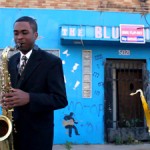A major change occurred in autumn 1948 when the management of the Blue Bird decided that it would specialize in the presentation of modern jazz. When the owners went all-out to make this spot “the hippest modern jazz nightspot” in Detroit during the city’s bebop heyday. But we must remember, there has been music at the club since the ’30s. In the 50’s Thad Jones, Tommy Flanagan, Thad Jones, Barry Harris and Elvin Jones were regulars. Even Joe Henderson would play there later in its life… Some say, even Charlie Parker dropped by to jam with the regulars. Miles Davis played their regularly for a brief period in 1953 while “kicking” heroin (he returned later in his career as a band leader). The emphasis shifted to touring acts in the late ’50s; and the music eventually faded by the ’70s, with sporadic revivals. Now, long empty, the building’s shell still stands as a tribute to a time gone by…

The Blue Bird Inn
“Until the early 1970s, it was a Mecca for local and national musicians who were developing the modern jazz we know today. The drummer Elvin Jones was among the first very well recognized players to appear at The Blue Bird. Charlie Parker made his appearance at The Blue Bird within a year of its switch to modern jazz. Many, perhaps most, of the nation’s most acclaimed jazz musicians played at the Blue Bird in the late 1950s and early 1960s. This was the city’s leading venue for jazz in a very prosperous era.
Many Detroiters would say that Miles Davis is a seminal figure in American music because of his links to the Blue Bird. By the early 1950s, he was recognized in New York as an extremely promising young player. However, his colleagues realized that he was developing a heroin habit and feared that it would destroy him. There is an often repeated story that his New York colleagues encouraged Miles Davis to move to Detroit since, they assumed, drugs in Detroit were of much lower quality than those in Gotham City and therefore easier to kick. Miles Davis, in his autobiography, tells the story differently. He claims that he realized his dependence on heroin and moved back to his parents’ home in St. Louis where he just quit. After going “cold turkey,” he decided to spend time in Detroit so he moved there in the fall of 1953 and took a room at a hotel located at the intersection of West Grand Boulevard and Grand River. Very quickly he was recruited to play at The Blue Bird Inn; perhaps by Buddy DuBois, a part owner who operated the venue. Miles remained in Motown for about five months, and according to his autobiography, did give up the use of drugs while a resident of this city. He wrote that the drugs in Detroit were very weak compared to those he got on the East Coast and that his colleagues described Detroit drugs as being as tame as chocolate bars. Miles Davis wrote that he received great help from the Detroit boxer Sugar Ray Robinson whom, I assume, was a regular patron of The Blue Bird Inn. In his book about jazz in Detroit, Lars Bjorn documents that Miles Davis spent several months in Detroit in 1953-54 and again for several months in 1954-55. Bjorn reports that Miles Davis apparently mixed story from those two long stays playing at the Blue Bird in the Motor City.
Buddy DuBois was shot to death in 1956 in front of the home of his girlfriend, a murder that remains unsolved. Clarence Eddins, a west side business man who apparently made his fortune in the numbers business, was a part owner of the Blue Bird Inn and took over. He closed the bar briefly in 1957 for remodeling and to accommodate it to seat a larger number of patrons. The following years were a particularly creative span for the Blue Bird. Eddins booked Detroit and national talent, including Miles Davis, John Coltrane, Horace Silver, and Art Blakey. Thad Jones, Yusef Lateef, Sonny Stitt, Cannonball Adderley and a variety of other distinguished modern jazz artists.
There are at least two pieces of modern jazz that identify this landmark: trumpeter Thad Jones’ “5021,” and Tommy Flannigan’s “Beyond the Bluebird.” (Via http://detroit1701.org)
The Detroit Sound Conservancy is a private, non-profit organization founded in 2012 to celebrate the musical heritage of the Motor City through education, promotion and preservation. In 2016, this organization obtained permission from the owner of this building to removed the hallowed stage of the Blue Bird Inn. Archaeologists from Wayne State University’s Anthropology Department in conjunction with the Detroit Sound Conservancy conducted an archaeological survey of the vacant building, looking for remnants of the Blue Bird’s past. They did so with the intent of making it portable. Presumably, it may be sited in other venues so that today’s musicians may perform on the same stage that once welcomed Miles Davis, Thad Jones and John Coltrane. UNESCO, every two years, organizes a celebration of creative design. The Biennale Internationale Design in 2017 was held in Saint-Etienne, France. The city of Detroit was a major feature of the program with numerous lectures, films and other presentations focused on the formerly French city we know as Motown. The stage from the Blue Bird Inn was transported to Satine-Etienne and installed fore the Diennale Internationale
Design. (via Model D)
Book about history of jazz in Detroit with many comments about The Blue Bird Inn
Before Motown: A History of Jazz in Detroit: 1920-1960. Lars Bjorn with Jim Gallert
(Ann Arbor: University of Michigan Press, 2004)
Miles Davis Autobiography: Miles: The Autobiography (New York, Simon & Schuster, 1989)
Website of the Detroit Sound Conservancy
Website of Biennale Internationale Design Saint-Etienne 2017
